![]()
![]()

A R T S A K H
T H E E A G L E ' S N E S T O F F R E E D O M
Written by Gevork Nazaryan
Since time immemorial Artsakh, a part of which is the now day Republic of
Mountainous Artsakh or Nagorno-Karabakh, has been one of the most important
cultural, spiritual, political and as well as economic centers of Armenia.
Artsakh beginning from the era of the powerful Armenian Kingdom of Ararat [Urartu
in Assyrian inscriptions] has made a significant contribution to the impetus and
advancement of Armenia and the Armenian people in all aspects. Artsakh, the
eagle nest of Armenian freedom and sovereignty has always kept -- at distinct
times to a different degree -- its independence and Freedom from the oppression
of foreign yoke. Under powerful aristocracy and royal dynasties such as the Aran
dynasty and mighty Armenian Warrior-Kings such as Vachagan the Pious, Artsakh
prospered and flourished. Artsakh has truly been the symbol of Armenian
vigilance and vigor throughout thousands of years of glorious history of the
Armenian nation. Today the Republic of Mountainous Artsakh or Nagorno-Karabakh
in itself embodies the Armenian spirit of tenacity and endurance. Unbelievably
beating all of the odds and fighting on in the face of every possible and
impossible obstacle fighting with the word NEVER AGAIN in their minds and their
lips, in order not to let history repeat itself... fighting the epic battle for
National Liberation and self-determination that all free peoples of the
civilized world deserve.
T H E C R Y F O R F R E E D O M !

L I B E
R T Y !
Artsakh -- occupies the eastern and the southeastern mountains and foothills of Lesser Caucasus mountain range, composing the northeastern portion of the Armenian Plateau or Armenian Highland. Artsakh, forming an archway, stretches from the mountains surrounding the eastern basin of Lake Sevan, to the southeast, as far as the river Eraskh [Araks]. The primary sources testify that Mountainous Karabagh was one of the original provinces of Armenia -- regardless of the different names [including Urtekhe-Urtekhini, Orkhistene, Tsavdek, Lesser Siwnik', Khachen, Karabagh] cited as the name of the land in various periods of Armenia's long history --, and the Armenian people have always been the native population of Artsakh-Karabagh. Artsakh served as a shield for the central regions of Armenia from the raids of nomadic tribes from the east. Starting from the 17th century In the nineteenth century, the famous traveler and explorer, Henry Finnis Blosse Lynch noted that Karabagh which had been inhabited by Armenians since the ancient times and was settled by the Tatar emigrants was the sound bearing point of defense for Armenia from the Caspian Sea.
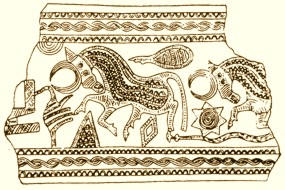
BRONZE BELT OF AN ARMENIAN WARRIOR FROM ARTSAKH, XTH CENTURY BC.
PROFOUND SUBLIME SYMBOLISM. TWO PARALLEL RUNNING LINES CONTAIN
INTERWOVEN HORIZONTAL ∞
INFINITY SERPENTS.
CRESCENT HORNED BULLS. THE SACRED BIRD [BRINGER OF THE DIVINE SPARK]
THE HEAVEN + EARTH DIAMOND, THE COSMIC EGG [PLEROMA],
COSMIC HIERARCHY HOLY MOUNTAIN/AXIS MUNDE/PILLAR
THAT CONTAINS THE SACRED MARKED DECADE TETRACTYS
1+2+3+4=10 AND A SERPENT BELOW THE SEVEN POINTED STAR.
The first evidence of the pre-historic age of Artsakh dates back to the Acheul
period of the early Paleolithic (500- 100 thousand years ago) era. These are the
ancient tools and osteological materials, found in the caves of Vorvan-Azokh,
Tsakhach, Unot, and Khoradzor. The maxilla of the Neanderthal man, discovered in
Vorvan- Azokh, has a special significance for the study of the anthropogenic
process.
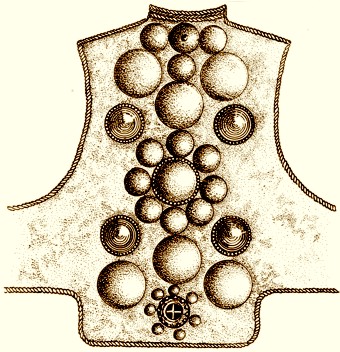
BREAST PLATE OF AN ARMENIAN WARRIOR FROM SECOND MILLENNIUM BC.
SIWNIK‛. ARTSAKH PROVINCE OF GREATER ARMENIA
WAS ALSO
CALLED LESSER SIWNIK‛ CONNOTING THE FACT THAT AT
ONE TIME
SIWNIK‛ ENCOMPASSED ARTSAKH AND PROBABLY UTIK‛ AND P‛AYTAKARAN
PROVINCES EXTENDING TO THE CASPIAN SEA.

POTTERY, JEWELRY AND A DAGGER FROM SIWNIK‛.
SECOND MILLENNIUM BC.
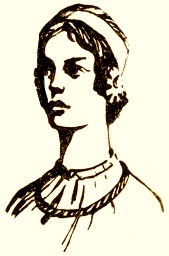
The excavations of the settlements as well as burial places of the Bronze and
Iron Ages, [Stepanakert, Khodjaly, Krkjan, Amaras, Mataghis, the valleys of
Khachenaget and Ishkhanaget] show important finds of the Kuro-Araks culture of
the fourth and third millennium BC.
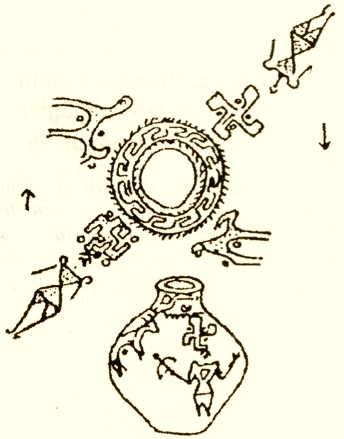
THE ANCIENT ARMENIAN 12-SPOKE COSMIC WHEEL OF ETERNITY
ON A DECORATED CEREMONIAL JAR FROM ARTSAKH. BEGINNING
OF FIRST MILLENNIUM BC. NOTE THE ARROWS SHOWING
THE CELESTIAL [ZODIACAL SCHEME] MOVEMENT OF THE SUN
THROUGH THE HEAVENLY BODIES [LUMINARIES].

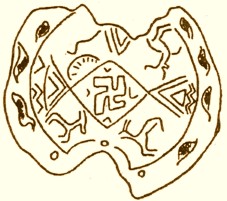
TRIPLE DECKER UNIVERSE ON POTTERY FROM
ŠAXOR, UT‛IK PROVINCE OF GREATER ARMENIA
[NORTH-EAST OF ARTSAKH PROVINCE...SEE MAP BELOW].
THE COSMIC WHEEL STANDING FOR CELESTIAL SKY/HEAVEN
IN BETWEEN TWO COSMIC MOUNTAINS [IN TURN TRIPARTITE]
BELOW THE MOUNTAINS SYMBOLS OF COSMIC WATERS/SOURCES/
AQUARIUS. FOUR DEER REPRESENT 'MIDDLE EARTH' OF THE TRIPLE
DECKER [SKY-EARTH-UNDERWORLD] AND THE OUTER PERIPHERY
INCLUDES FISHES...SUBTERRANEAN LAYER.
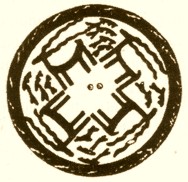
For Indo-European scholars, the unique discoveries in and around Stepanakert and
the valley of the Kachenaget, dating back to at least third millennium BC, are
of special significance. According to a number of Indo-Europeanists, the
Armenian Plateau is the cradle of the Indo-Europeans.

ONE OF THE CUNEIFORM INSCRIPTIONS ISSUED BY KING RUSA II
At the beginning of the first millennium BC, Artsakh entered the
political-cultural sphere of the Kingdom of Ararat (Urartu). In one of the
Khodjaly regions a bead and a cornelian, bearing the name of the Assyrian king
Adad-Nirari who invaded Artsakh during this period, were discovered. A cuneiform
inscription of the Urartu king Sardur II was discoverd nearby stating that
Artsakh is part of the Urartu Kingdom.
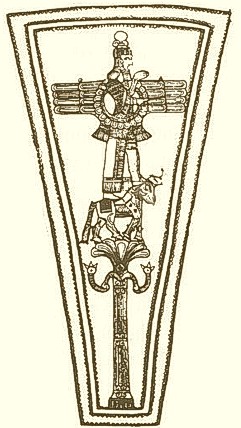
TEYŠEBA WITH THE SOLAR WINGED DISK UPON THE COSMIC TREE
ONE OF THE TRIAD OF SUPREME GODS OF THE ARARAT PANTHEON
Artsakh was particularly important in fighting to preserve the strength of
the Armenian State against foreign invaders. Between 550-331 BC, the Armenian
Kingdom, including Artsakh, was under the nominal rule of the Achemenids.
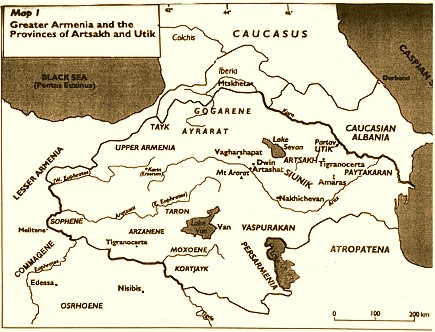
GREATER ARMENIA AND THE PROVINCES OF ARTSAKH [10TH PROVINCE] AND
UT‛IK.
The borders of the Armenian State, formed by the Artaxiad dynasty in the early
2nd century BC, passed along the river Kur. According to the evidence of a
number of Graeco-Roman and Armenian primary sources, the Kur river was the
northeastern frontier of Greater Armenia, with the Province of Paytakaran
reaching the shores of the Caspian Sea. Artsakh, the Tenth Province or
Ashkharh of Greater Armenia was ruled by the Aran or Aranshahik [lit. 'Aran
kings'] noble family.

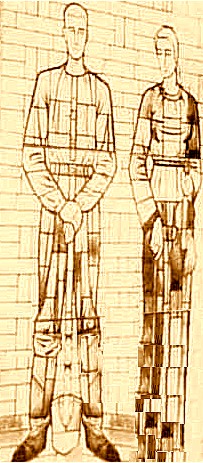
HIGH MSHAK. ARMENIAN LOVE AND ATTACHMENT
TO THE LIFE-GIVING SACRED MOTHER ARMENIA-SOIL IS DEEP.
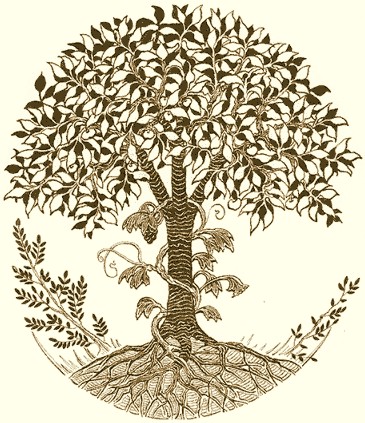
THE TREE OF LIFE.
According to the Greek primary sources of the first century BC, Artsakh [Orkhistene] is noted as one of the most important fifteen Armenian provinces of Greater Armenia. "The Armenian provinces include Favnena, as well as Kombisena and Orkhistena, and Orkhistena [Artsakh] provides the largest number of horsemen', notes the renowned historian Strabo. As an eyewitness and a contemporary historian, Strabo notes that that during the reign of the Armenian king Artashes [Artaxerxes] I [189-160 BC] in Armenia "nowadays all of these peoples speak the same language [Armenian]."

QUEEN ERATO OF THE ARTAXIAD DYNASTY
In the middle of the first century BC, Greater Armenia became the most powerful
state in the Near East. The King of Kings Tigran II the Great of the Artaxiad
Dynasty, attached great importance to Artsakh and built in the province the city
of Tigranakert (not to be confused with the capital Tigranakert in the Alznik
Province), making it one of the four cities and strongholds bearing his name.
Ruins of this town are in the environs of the present day Aghdam. In the place
of the ancient town there remained barrows, stone sculptures, cult erections,
hollowed out in the rock formation and cliffs.
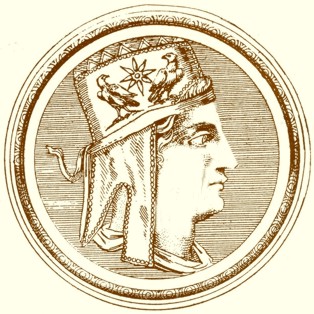
THE KING OF KINGS METSN TIGRAN ESTABLISHED THREE
NEW
CITIES IN GOŁT‛AN -- TIGRANAVAN --
[HOME TO MANY G U S A N S
THE GREAT TROUBADOUR BARDS OF ARMENIA] PROVINCE OF SIWNIK‛ AND
IN UTIK‛ AND ARTSAKH TWO NEW CITIES BOTH NAMED T I G R A N A K E R T
Between 66 - 428 AD, during the reign of the Arsacid dynasty, Artsakh constituted an important political and socio-economic province of Greater Armenia. After the fall of the Arsacid Dynasty, Artsakh was occupied and annexed by the neighboring Caucasian Albania, situated to the north of the river Kur. In 469 the said kingdom was reformed into a Persian marzpanate, retaining the name Albania.
C A U C A S I A N W A R R I O R S

THE FREEDOM LOVING HIGHLANDERS OF SIWNIK' AND ARTSAKH
FOUGHT THE TYRANNY OF FOREIGN INVADERS IN ORDER
TO PRESERVE THEIR HONOR AND LIBERTY
In early forth century, Christianity spread rapidly spread throughout Armenia,
including Artsakh, promoted by Catholicos Aristakes, the son and successor of
St. Gregory the Illuminator. At the beginning of the fifth century, the revival
of the use of the Armenian alphabet by Mesrop Mashtots, led to an unprecedented
rise of high culture throughout Armenia in general, and the Artsakh province in
particular. Mesrop Mashtots founded one of the first Armenian schools in the
Artsakh monastery of Amaras.
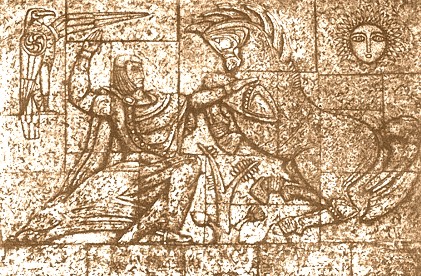
THE ARMENIAN ARISTOCRACY HEADED THE RESISTANCE AGAINST FOREIGN
TYRANNY
Throughout the fifth century the eastern part of Armenia, including Artsakh, continued to remain under the Persian rule. In 451, the Armenians in response to the policy of forced conversion to Zoroastrian fire-worship organized a powerful revolt that became known as the Vardanants' War, named after the general hero -- Vardan Mamikonian -- who led the Armenian forces. The nobles of Artsakh joined the liberation war, its mounted cavalry particularly distinguished itself in the battlefield with its skill and bravery. After the suppression of the revolt a considerable portion of the Armenian forces took shelter in the numerous impregnable fortresses and thick woods of Artsakh, from where they continued a guerrilla warfare against foreign occupation. In the beginning of the sixth century, Artsakh and neighboring Utik Ashkharh, united under the rule of the Aranshakhiks, with Vachagan the Devout, as the head (487-510’s) of the two Armenian provinces.

The fifth century historian Agatangelos testifies that the winter residence of the Armenian kings was in the Utik Province of Greater Armenia on the western banks of the Kur river, northeast of Artsakh.

WOOD [WALNUT] PANEL. PROBABLY FROM DADI VANK. X-XIITH
CENTURY. MITHRAIC ARMANI SYMBOLISM. FOUR MARKED LAYERS.
TWO LIONS FACE EACH OTHER.
EQUILATERAL SPLIT [FISH TAIL...EA-ENKI] CROSS WITH RINGS OF
INFINITY WITHIN THE ARCH/GATE/LIBRA/SCALES/BALANCE [THREE POINTS]
FLANKED BY SERPENTINE SPIRALS SPINNING RIGHT AND LEFT.
INTERWOVEN CIRCLES FORMING THE RIGHT AND LEFT DIRECTION COSMIC WHEEL,
MALTESE CROSS, STAR OF EA [VISHNU]. TWO EAGLES FACING EAST AND WEST...
MACROCOSM. HORSEMAN HUNTER [HAYA - ORION - HAY[A]K [SON OF EA-AYA] -
MIHR/MHER]. SAGITTARIUS -SAINT GEORGE [ACCOMPANYING
ASTRONOMICAL SYMBOLS INDICATE TERRESTRIAL-CELESTIAL MIRROR
DOUBLE MEANING CONCEPT. HEXAGONS AND CIRCLES FORM THE
SYMBOL OF THE MACROCOSM AS THE ANIMAL [NATURE] IS VANQUISHED
BY THE MAN-MICROCOSM...AREVORDI - ARORDI...CHILDREN OF THE SUN
KEPT ALIVE THE NATIONAL TRADITION AND HERITAGE OF
THEIR ANCESTORS.
In the fifth century Artsakh is also mentioned as Pokr Siwnik' of Lesser Siwnik'. According to the fifth century historian Movses Khorenatsi, who is considered the Father of Armenian History, after the death of Catholicos Grigoris in the field Vatnyan, the Church bishops took his body to Lesser Siwnik' and buried him in the village of Amaras.
Fifth century historian Ełishē writes that after the epic Battle of Avarayr in 451, many Armenians who initiated the national liberation struggle against Persia continued the struggle from "the southern impassable lands of Tmorik and the forests of Artsakh."
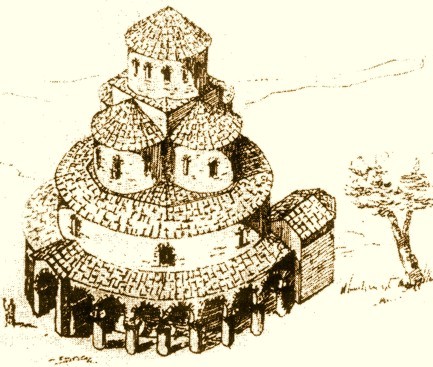
THE CHURCH OF LEKIT‛. IN
LESSER SIWNIK‛ ARTSAKH.
THE INFLUENCE OF THE ZVARTNOTS STYLE IS IMMEDIATELY NOTICEABLE.
The seventh century Ašxarats'oyts' [Geography] notes "Greater Armenia is divided into 15 ašxarhs [provinces], including …. Artsakh, Siwnik' and Utik'…". In the works of the Grćco-Roman and Armenian historians clearly indicate that the River Kur forms the border between Armenia and Caucasian Albania [Aluank'].
The Roman historian Claudius Ptolomeus wrote: "From the north, Greater Armenia borders Kolxida, Iberia and Albania, and the border passes along the River Kur."
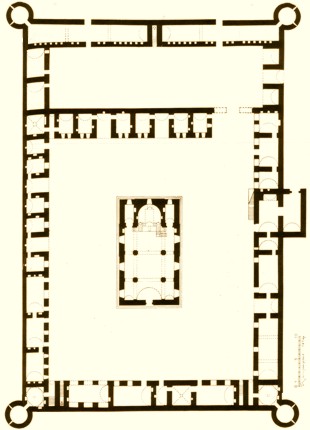
GENERAL PLAN OF THE A M A R A S COMPLEX

RUINS OF THE MEDIEVAL MAYRABERD FORTRESS IN CENTRAL ARTSAKH.
Another fifth century historian, Phaustos Biwzand wrote: 'He [Mushegh Mamikonian - leading representative of the Mamikonian nobility during this time] established the border of Armenia and Albania along the River Kur, as it formerly used to be". The Maskut king Sanesan "crossed his border -- the River Kur -- and invaded into the country of Armenia".
By the end of the of the sixth century, the Albanian marzpanate was broken into several small principalities and the collective name "Albania" or "Albanians" no longer applied, as they henceforth appeared under the name of the local ruling houses.
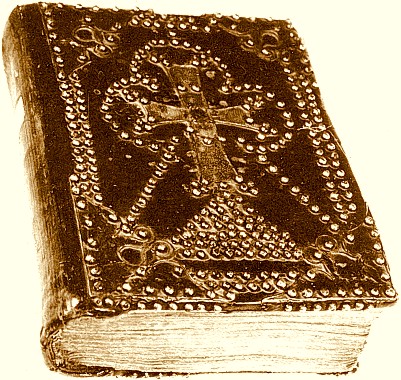
XIIITH CENTURY LETTER BOUND MANUSCRIPT SYMBOLICALLY INLAID
WITH THE ARMENIAN CROSS AXIS WITHIN A TRIUNE ABOVE THE COSMIC
HIERARCHY TRIANGLE. MATENADARAN MS. NO. 4283.
In the South Artsakh and Utik united to form a separate Armenian principality under Aranshahik nobility. In the seventh century the Aranshahik House was succeeded by the Mihranian [named after the Armenian national Sun God Mihr or Mithras] House.
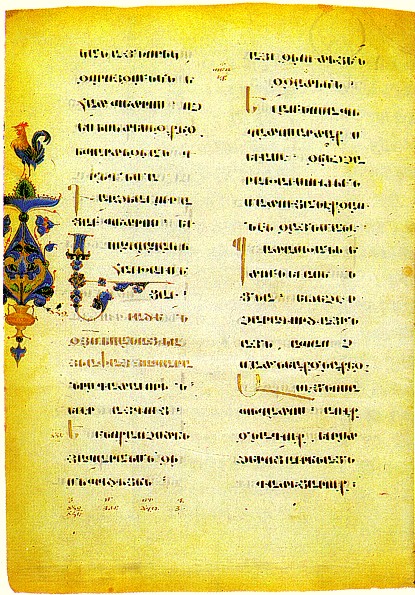
THE RED GOSPEL [909]. MATENADARAN MS NO. 6209 P. 1b.
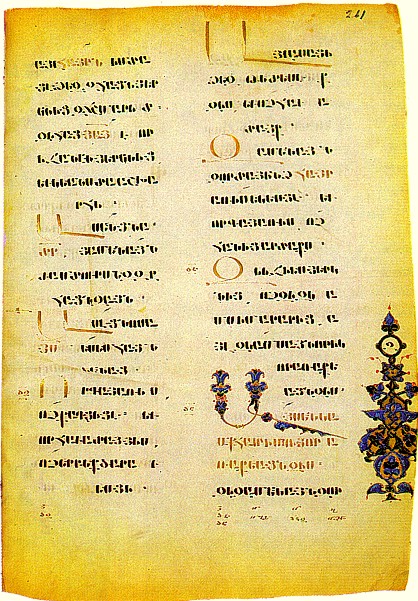
GOSPEL 1266]. MATENADARAN MS NO. 5448 P261a. ATTRIBUTED TO TOROS
ROSLIN.
In the second half of the seventh century in the initial period of Arab rule, the political and cultural life of Artsakh continued to progress. The newly established monasteries of Amaras, Orek, Katarovank, Djrvshtik became significant centers of Armenian civilization.
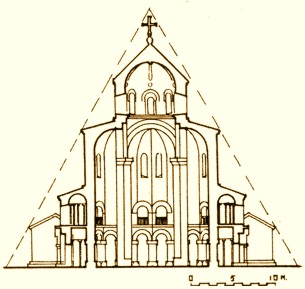
THE CHURCH OF LEKIT‛. TWO
DIMENSIONAL [INTERIOR-EXTERIOR] VIEW
ON A NORTH-SOUTH AXIS. THE APEX POINTS TO CELESTIAL HEAVEN.
Step'anos Siwnets'i, an Armenian poet and grammarian of the seventh to eighth centuries, indicates the existence of numerous Armenian dialects: "And in order to master the [Armenian] language, one should be familiar with all of the dialects, like the dialects of Korchaik and Tayk, Khut, and Fourth Armenia, and Sper, and Siwnik', and Artsakh."
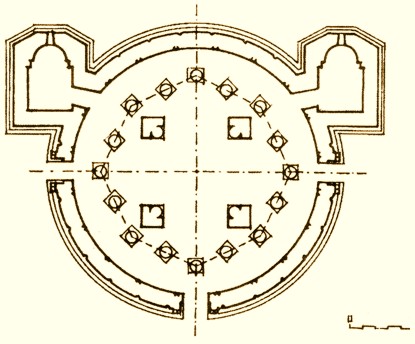
FLOOR PLAN OF 'ZVARTNOTS-ESQUE' LEKIT‛.
Beginning in the ninth century, the princely houses of Khachen and Dizak were the leading representatives of the aristocracy. The prince of Khachen, Sakhl Smbatian, and the prince of Dizak, Esaie Musse, spearheaded the struggle against foreign oppression.

GOLDEN RELIQUARY. KHOTAKERATS ST. NSHAN. 1300.
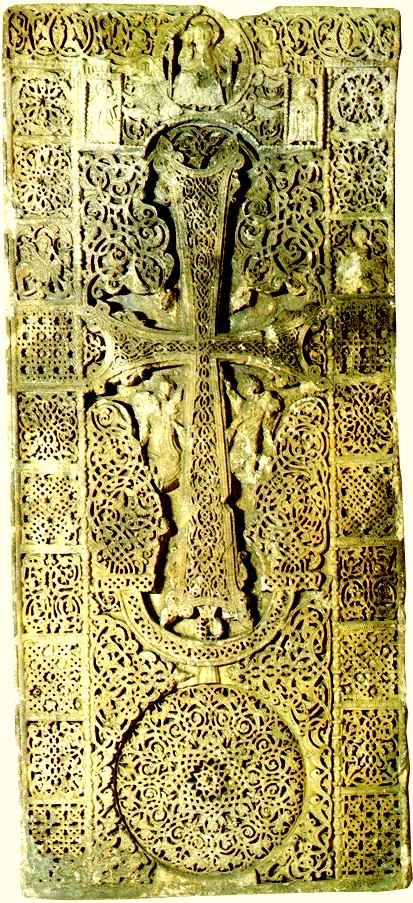
C R
O S S - S T O N E.
A R T S A K H. X I I I
T H C E N T U R Y.
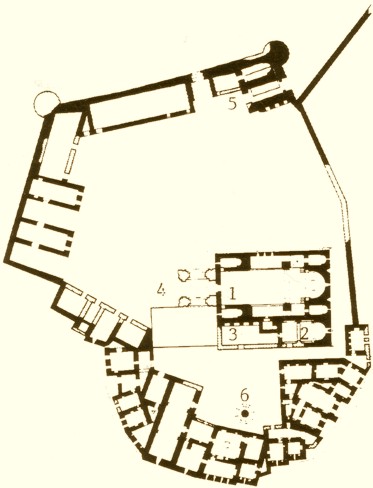
TAT'EV MONASTERY COMPLEX IN SIWNIK'.
CONSTRUCTION OF THE CHURCH OF PETER AND PAUL
BEGAN IN 895 AND WAS COMPLETED IN 906.
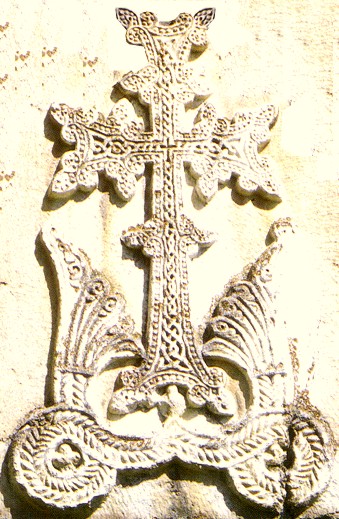
C R O S S - S T
O N E. A R T S A K
H. X I I I T H C E N
T U R Y.

MARKERS OF THE ARMENIAN MASTER BUILDERS FROM THE MIDDLE AGES.

The political, social-economic and cultural aspects of Artsakh are more
broadly
described in The History of Aluank' Country by the tenth century
historian Mowsēs Dasxurants'i.
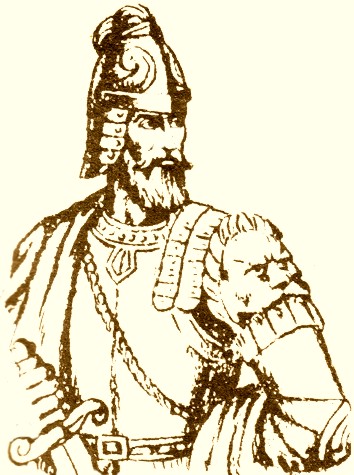
N A K H A R A R S -- THE ARMENIAN NOBILITY LED THE
WARRIOR CASTE

RUINS OF A MEDIEVAL FORTRESS IN TIGRANAKERT, ARTSAKH.
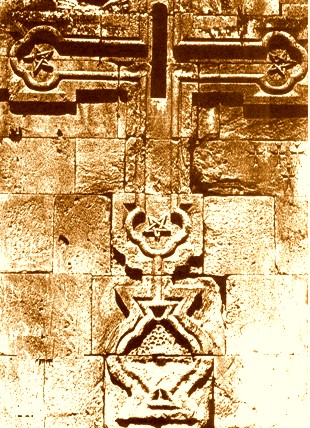
THE CROSS OF ARMENIAN ALCHEMISTS ON THE EXTERIOR OF THE
WHITE [SPITAKAVOR] CHURCH IN SIWNIK [SYUNIK] PROVINCE. XIIITH CENTURY.
FOUR INTERWOVEN PENTAGRAMS POINTING UP, DOWN, RIGHT AND LEFT...
BELOW THE SYMBOL OF THE UNION OF HEAVEN + EARTH DEPICTED
WITH TWO CONVERGING TRIANGLES UNTO THE PRIMORDIAL COSMIC EGG
[ETERNAL RETURN TO HARMONIOUS WHOLENESS].
THE LUSAMUT [SPIRITUAL ENTRY POINT OF LIGHT] WINDOW IS
RIGHT IN THE HEART/CENTER OF THE CRUX.
IT IS HERE THAT THE REMAINS OF THE GREAT NATIONAL HERO COMMANDER
GAREGIN NZHDEH WERE CEREMONIALLY LAID TO REST.
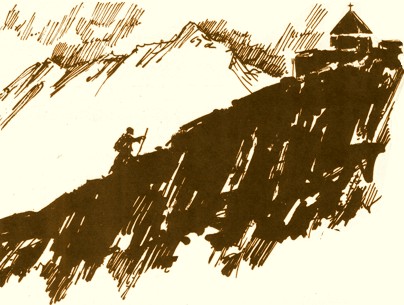
A HIGHLANDER'S PILGRIMAGE. TO THE
SACRED ABODE OF THE ANCESTORS
[CHURCH ERECTED ON THE VERY SPOT OF MITHRĆVM
ON THE ANCIENT
BLUEPRINTS OF ARMENIAN MASTER BUILDERS].
From the rise of the Arabic Caliphate to the re-establishment of the Armenian State under the leadership of the Bagratids (885), Artsakh constituted an important part of Armenia.
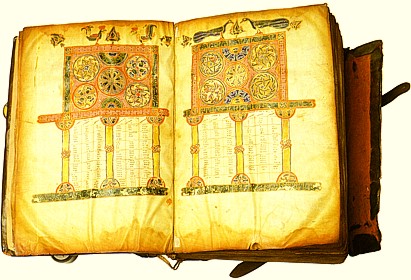
ONE OF THE BEAUTIFUL ARTSAKH GOSPELS FROM 1261.
MS NO. 378 KEPT IN THE MATENADARAN.
Starting from the tenth century, Artsakh is mentioned in the primary sources as the principality of Khachen. During the ruling of Prince Sakhel Smbatian the center of the principality became the fortress-stronghold of Khachen, which also served as the seat of the princely residence. The Byzantine Emperor Constantine addressed his letters to the prince of Khachen with the inscription "To Prince of Khachen, Armenia."
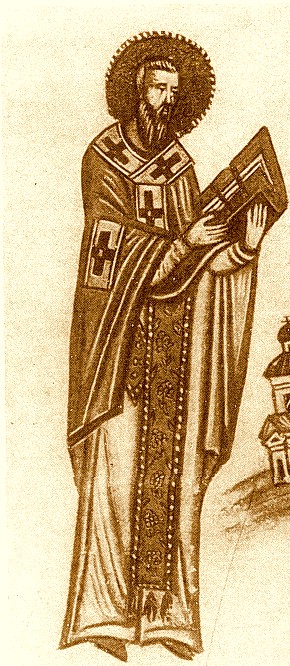
MANUSCRIPT DEPICTING M. KHORENATSI
-- THE VTH CENTURY FATHER OF
ARMENIAN HISTORY CANONIZED AS A SAINT BY THE HOLY
APOSTOLIC CHURCH FOR HIS MAGNUM OPUS.

FLOOR PLAN OF GANDZASAR MONASTERY.
[SEE BELOW...]
A primary source by an Arab historian notes that not long before the Mongol raids, when the troops of Jelal ad-Din invaded Transcaucasus, Artsakh's Armenian prince Hasan, the founder of the famous Gandzasar Monastery (1240) fought Sharaf al-Mulq, who had invaded Transcaucasus to collect ransom. The Armenian Prince paid the lump sum tax and set free the Moslem prisoners: "[Sharaf al-Mulq] stopped near Khachen Fortress where Jelal ad-Din, the nephew Ivanē al-Kurjhi was residing. Sharaf al-Mulq assailed him with threats until an agreement was reached under the condition that 10,000 dinars would be paid to Sharaf al-Mulq and 700 Moslem prisoners would be released that had been captured during different times."
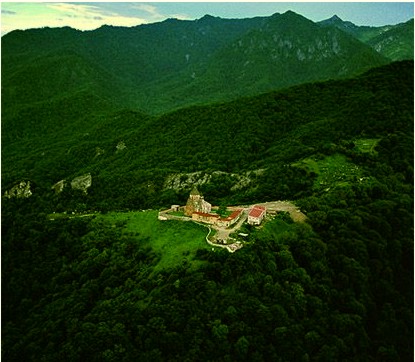
AERIAL VIEW OF THE ENCHANTING G A N D Z A S A R LIT.
TREASURE MOUNTAIN...
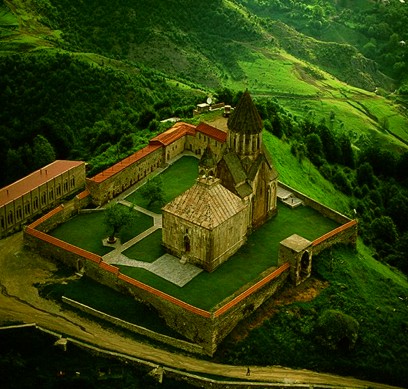
SPECTACULAR AERIAL [CLOSE] VIEW OF GANDZASAR IN THE HEART OF
ARTSAKH.
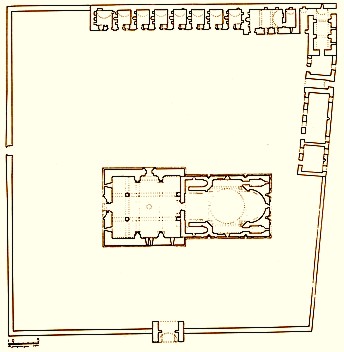
GENERAL PLAN OF THE G A N D Z A S A R COMPLEX

ONE OF THE INTRICATELY CARVED DOORS OF GANDZASAR MONASTERY. THE
TRADITIONAL ARMENIAN CROSS MARKED WITH THREE [TRIUNE] RINGS IN
FLEUR-DE-LYS-ESQUE PATTERN [CENTRAL 'CONIC' TIP]. HERMETIC INTERWOVEN
DNA SERPENTS RUNNING ACROSS THE SPINE AND ARMS [VERTICALLY AND
HORIZONTALLY] MALE + FEMALE UNION FORMING THE CUBIC [6+2=8 POINTS...]
SWASTIKA IN THE CENTER. THE COSMIC CRUX EMANATES FROM THE WHEEL OF
ETERNITY. 8-ESQUE [VULVA] SIGNS OF INFINITY RINGS [ALONG WITH RIGHT AND
LEFT SPIRALS] THROUGHOUT. THE GATE TO THE SANCTUM TOPPED BY
![]() THE
THE
ARCH/BALANCE/HARMONY...DOORWAY TO HIGHER CONSCIOUSNESS...
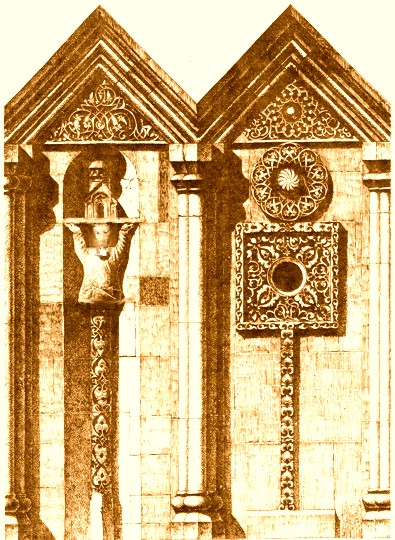
ATLAS DEMIURGOS.
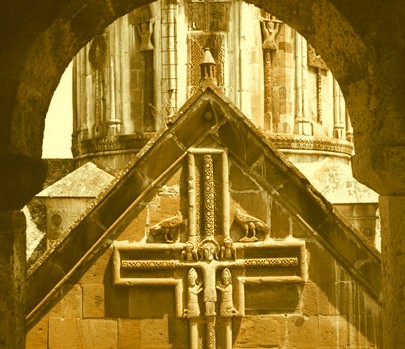
In the tenth century, the principality of Khachen encompassed much of the historic Artsakh of Greater Armenia and became one of the important cultural and political bastions of the time period. The Turkic nomadic raids from the steppes of Central Asia did not disrupt the social order of Artsakh. The Turkic nomads only raided and withdrew to their moving tents without making a foothold in Artsakh proper. The principalities successfully defended and checked the nomads' advance into Armenian lands. In fact, the end of the twelfth century and the first half of the 13th century became one of the most favorable periods for Artsakh's overall flourishing. During this period rich architectural complexes such as the Church of John the Baptist and the vestibule of the Gandzasar [Treasure Mountain] Monastery [1216-60], the Dadi Monastery [1214], and Gtchavank Church [1241-1248] were erected.
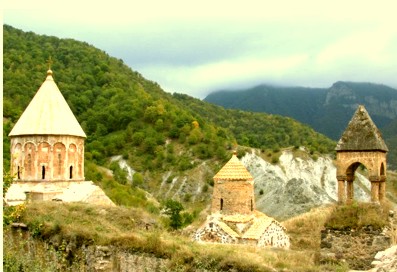
DADIVANK‛ IMBUED WITH
SACREDNESS HIGH IN THE MOUNTAINS OF VARANDA...

GENERAL PLAN OF THE D A D I V A N K‛ COMPLEX.
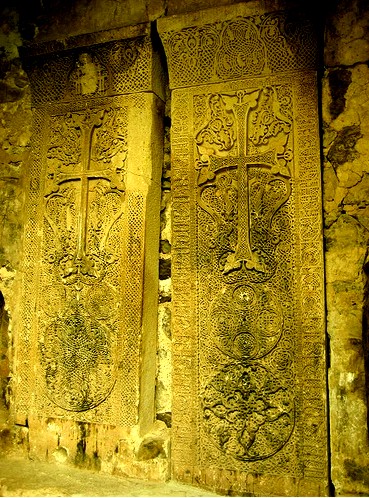
THE BREATHTAKINGLY BEAUTIFUL, SOLEMN, TALL AND PROUD
MEDIEVAL KHACHKARS OF DADIVANK‛ MONASTERY.
PAINSTAKING
FINE DETAIL AS IF SOWN IN CLOTH RATHER THAN SOLID ROCK.
In the first half of the thirteenth century, the Tatar-Mongols overran much of the Caucasus. The efforts by prince of Khachen Hasan-Djalal succeeded in partially saving Artsakh from being overran and pillaged. However, after his death in 1261, peripheral lands of the Principality of Khachen were raided and looted by the nomads. The situation became worse in the fourteenth century, when the Kara-Koyunlu and Ak-Koyunlu Turkic sheep herding nomads also raided parts of Artsakh.
KEYS OF DESTINY

THE RELIQUARY OF KING AŠOT THE IRON
[914-928].
The name "Karabagh" is first mentioned in the 14th century literature. Geographically, it corresponded to the territory of the Khachen principality. "Today it is called Łarabał [Gharabagh or Karabagh] and Mułan", a Georgian historian wrote.

GOSPEL [1053]. MATENADARAN MS NO. 3793 P. 49b.
In the sixteenth century in Artsakh a number of original administrative-political entities known as melikdoms or principalities were formed and ruled by the Armenian meliks. They were united in 5 melik states -- Varanda, Khachen, Dizak, Djraberd, Gullistan.

Throughout the sixteenth and seventeenth centuries, the princes of Artsakh, headed the National Liberation struggle of the Armenians against foreign domination. Simultaneously, with the armed struggle, Artsakh's princes sent their envoys to Europe and Russia in order to receive help from the West.
![]()